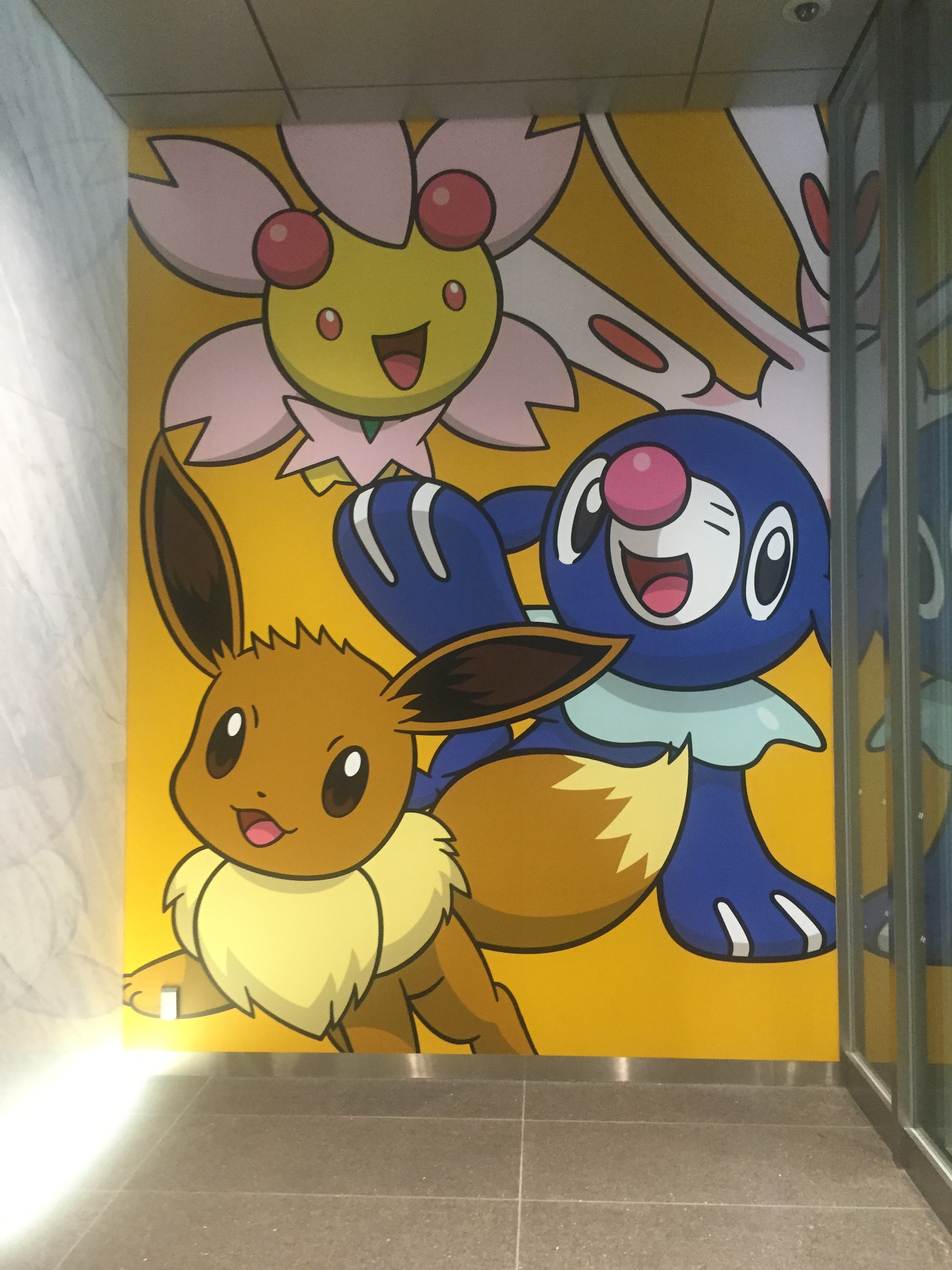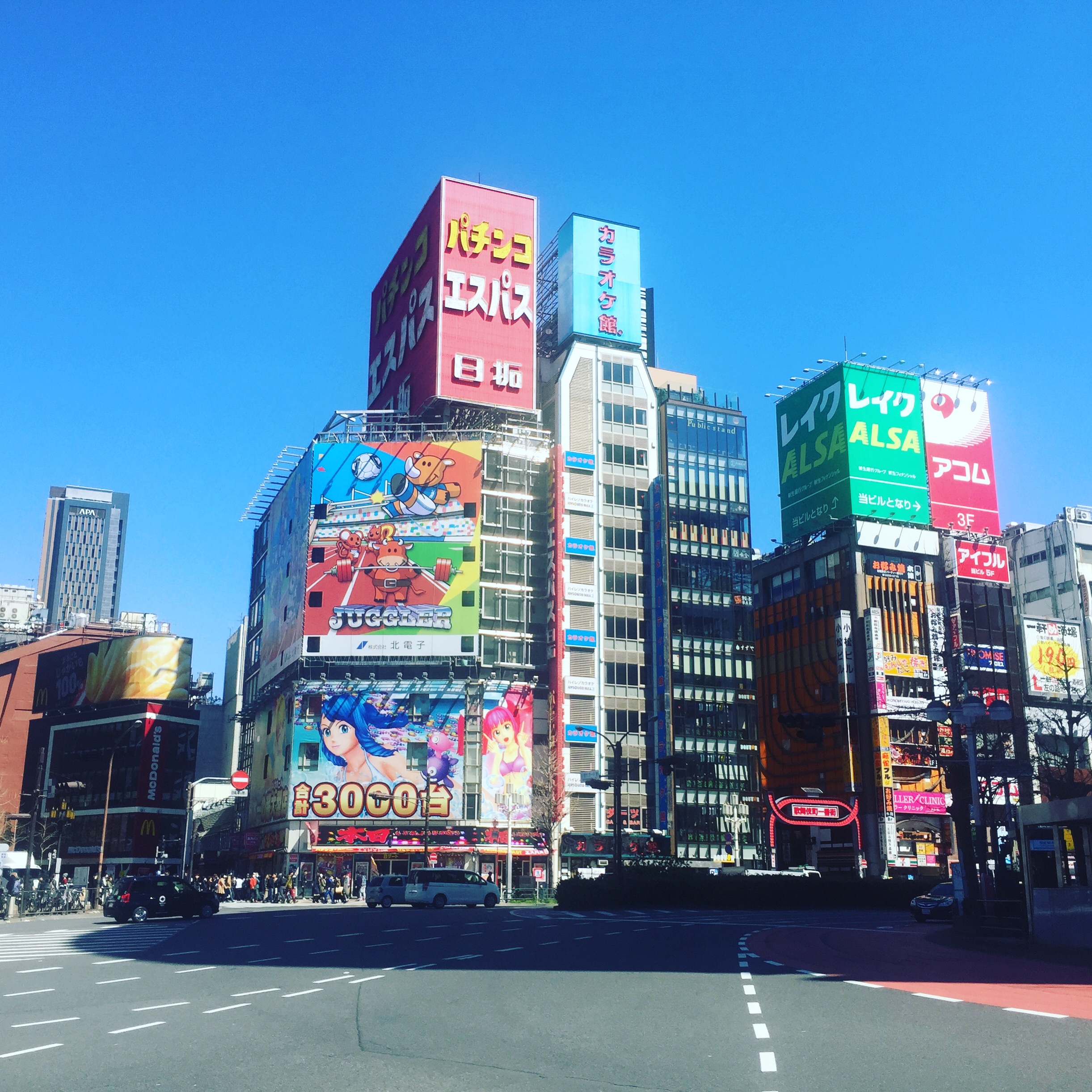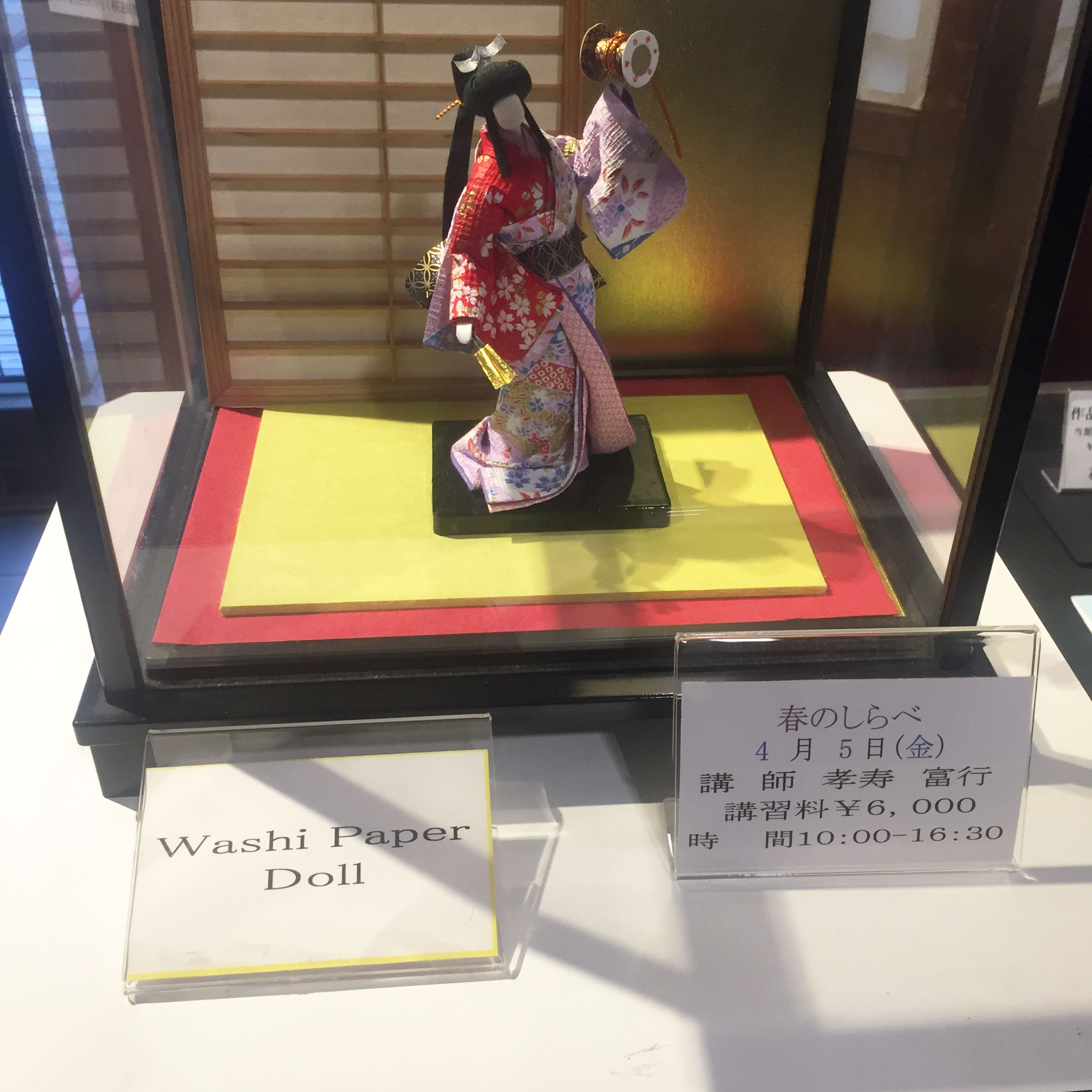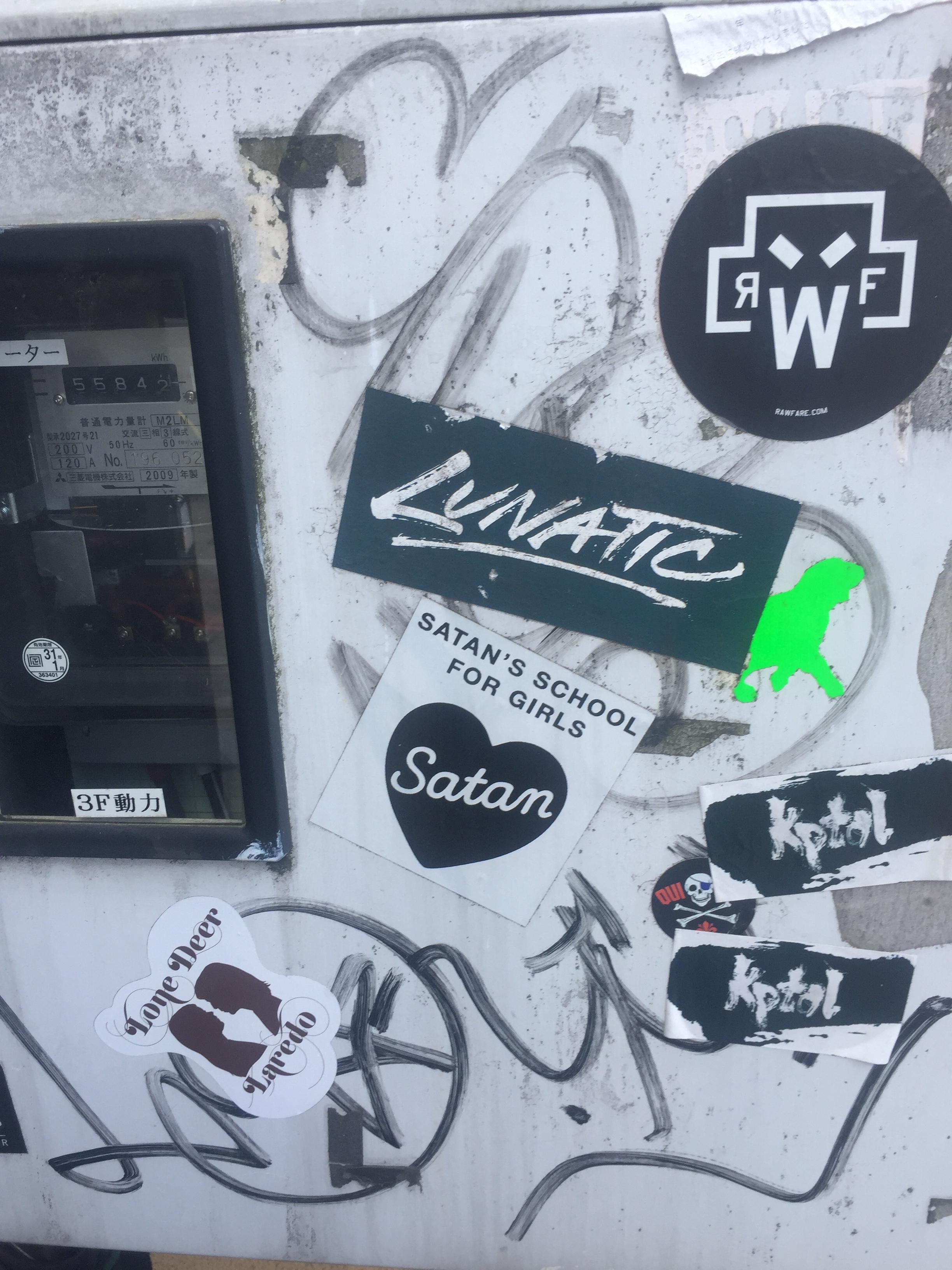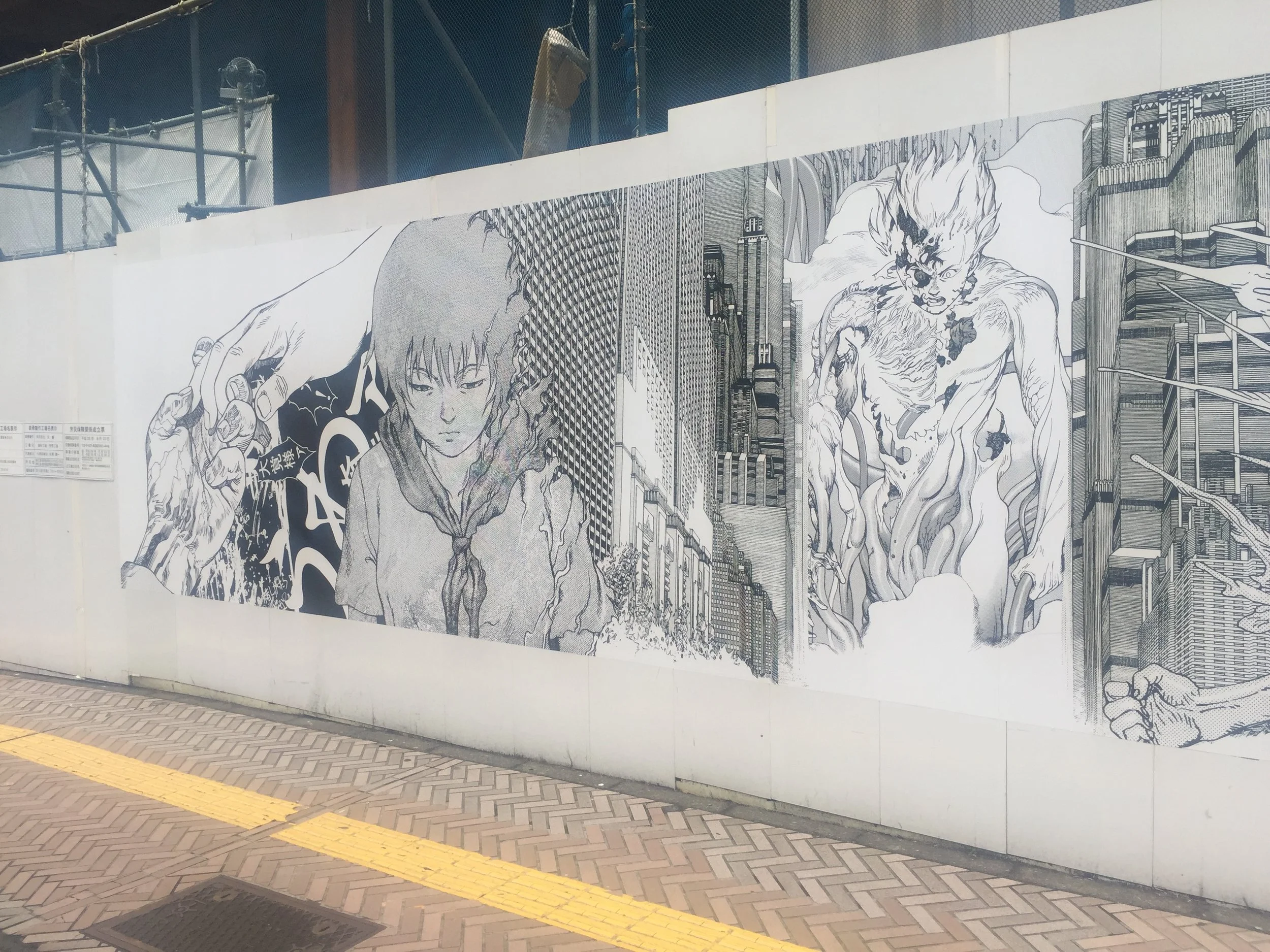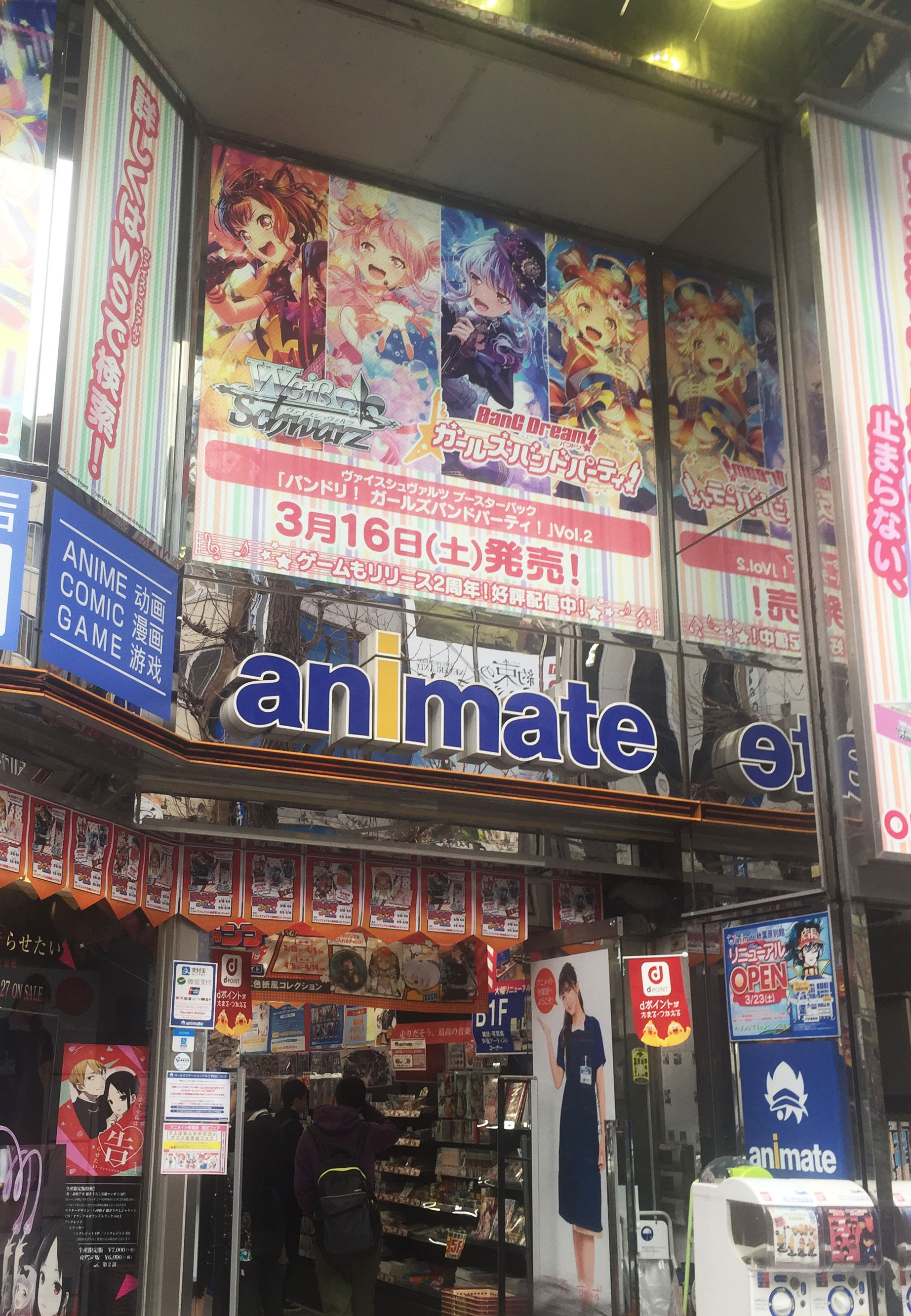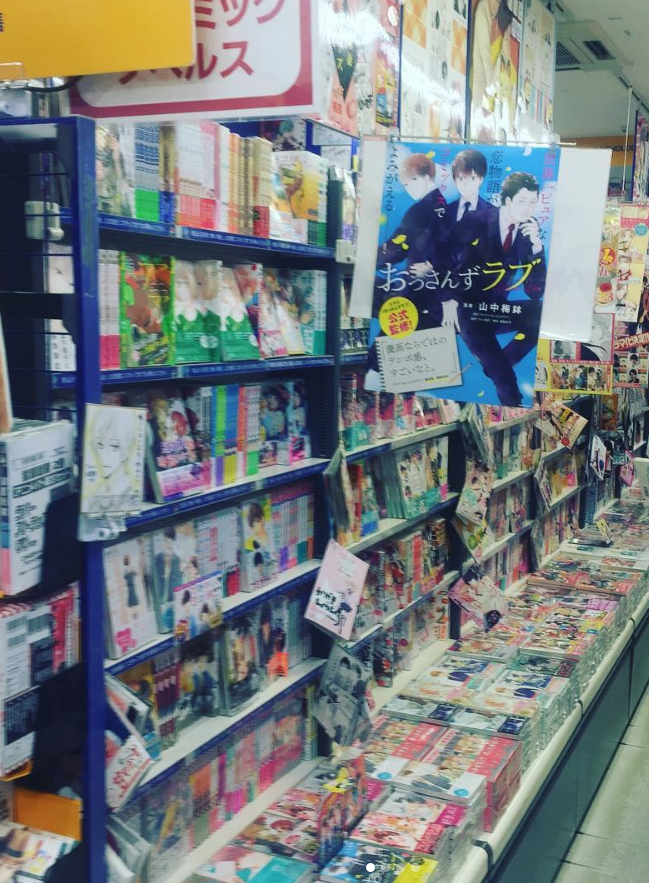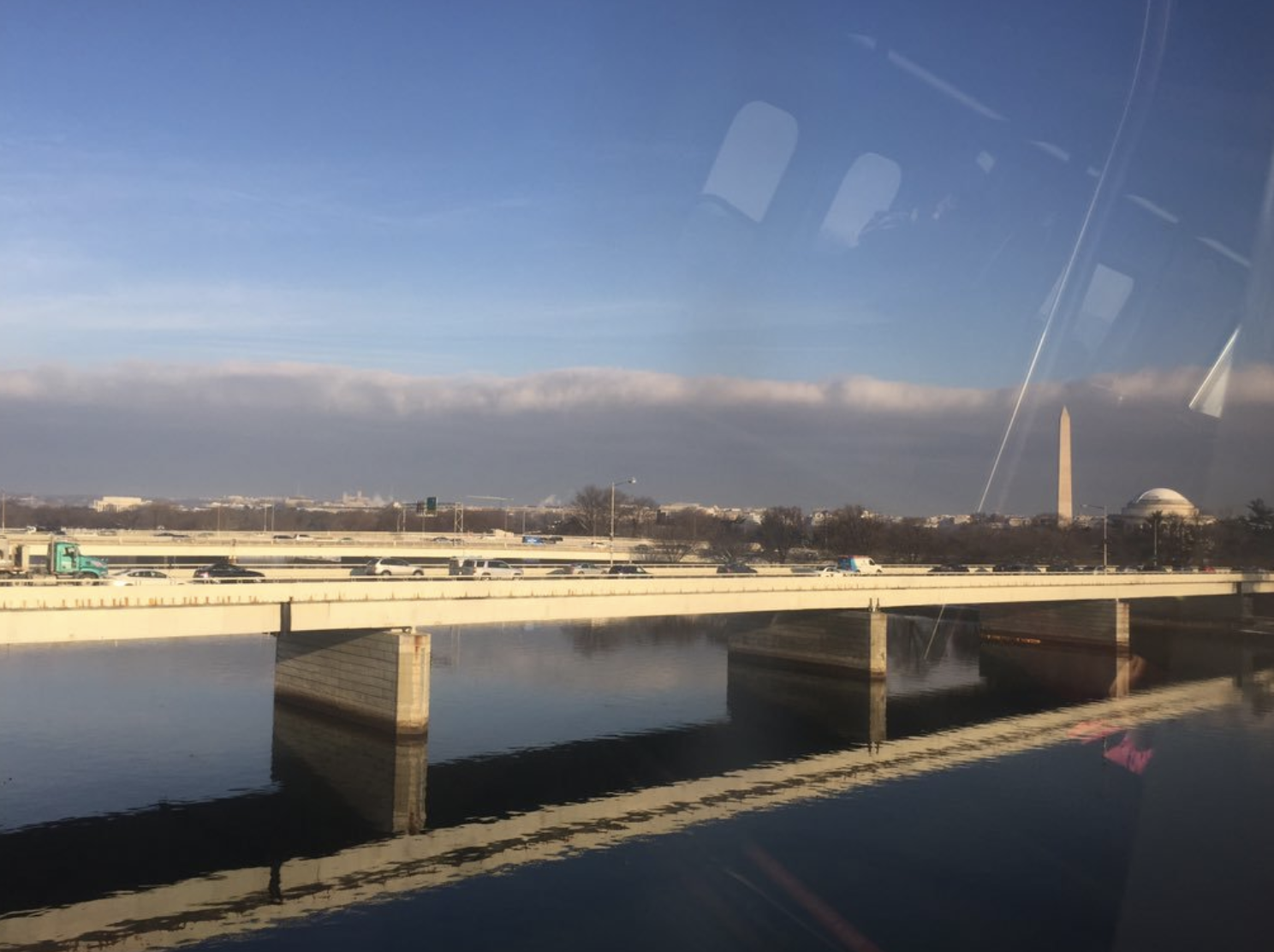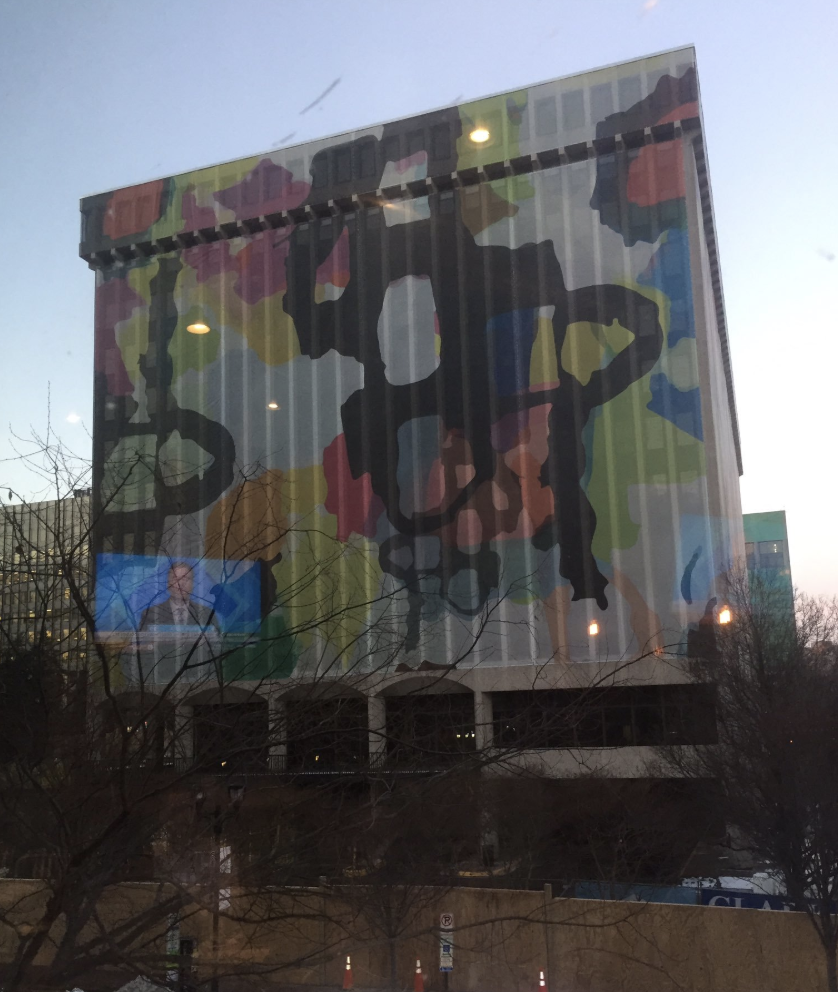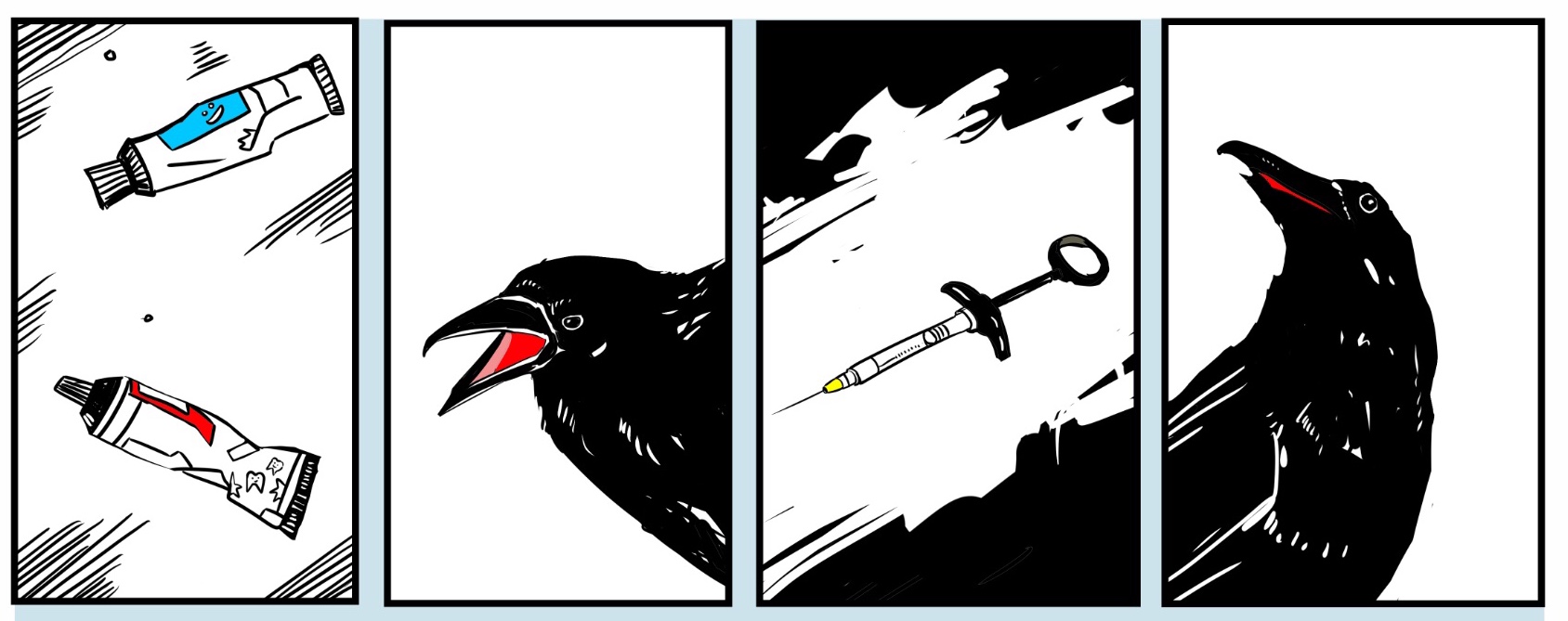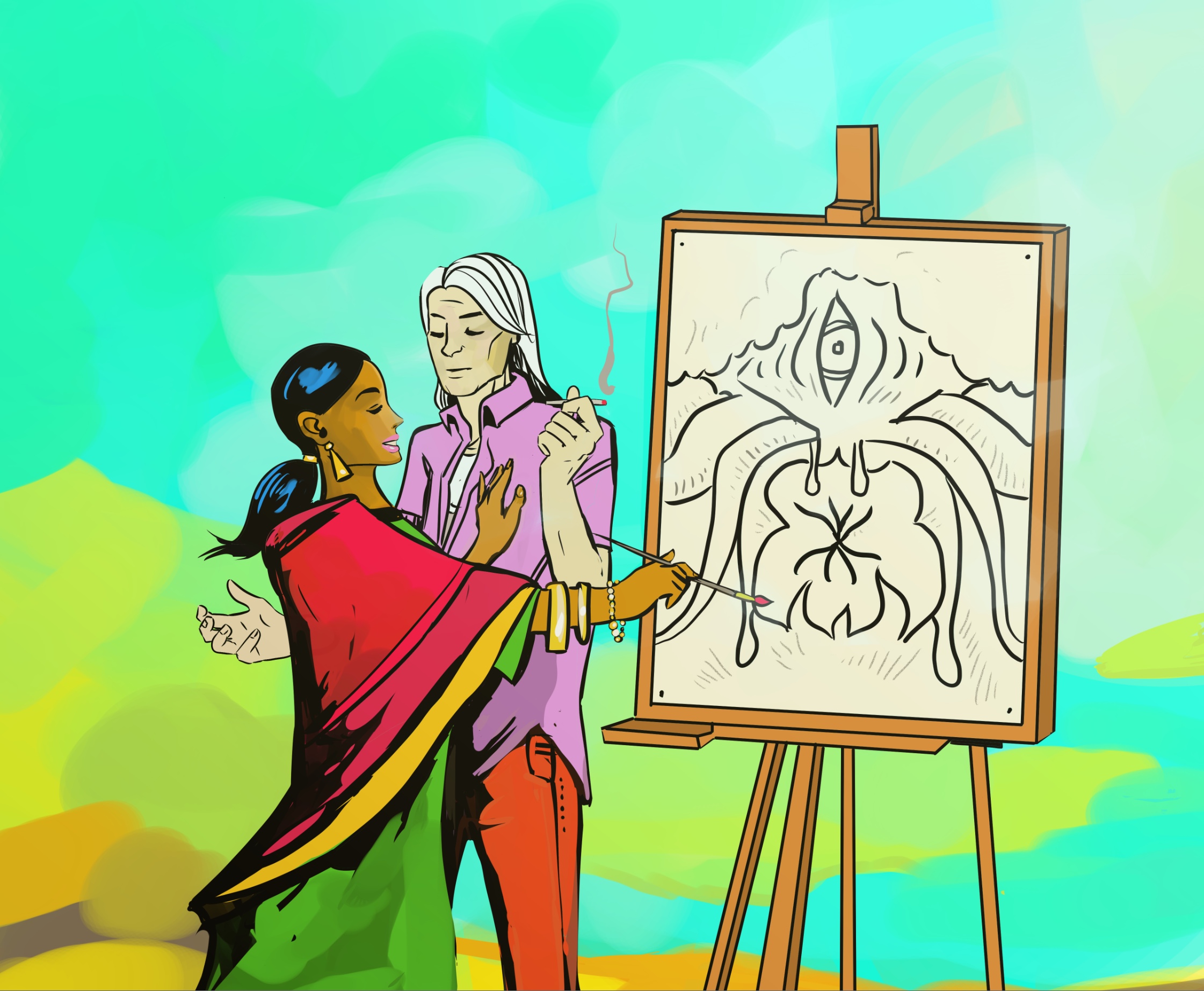You played Pokemon Red or Blue or at least Gold and Silver! You mustered enough cash to get to Japan. You aren’t embarrassed that you still like Pokemon.
Read MoreDay and Night in Shinjuku
Food everywhere, six-story book stores, multi-level shops, ramen and host clubs for days, After wandering around Shinjuku Gyoen Gardens at full Hanami in a state of bewildered dazzlement, I found myself wandering around Shinjuku the city.
Shinjuku looks a lot like you might imagine, like a concept-art vision of Blade Runner where the artist busted out the Good Watercolors. It’s more adult than Harajuku but still pretty Hello Kitty, with surprises like DVD stores and Mexican Food Casa Tequila as well as old standbys like an H&M where you could buy shirts with Garfield on them. Shinjuku only has everything.
While most of Shinjuku sparkled with a kind of jammed hypercompetitive bravado (Visit our ramen shop, see the Robot Restaurant! Godzilla! Movies!) graffiti and trash floated around in a couple alleys or places you weren’t supposed to notice. I liked this a lot about Shinjuku - the little punkass things in the city felt like hanging out with the goth girl who knits a sweater during the high school musical. When there’s so much panache and light and brigades of masterfully-produced Host Club trucks rolling by you, observing the graffiti feels so sweet. Getting a seat at a 6-person ramen shop feels like winning the lottery.
In buildings like the Taito Game tower above, you could play Pachinko or beefy arcade games the likes of which have never crossed the Pacific and never need to, it would all be just too much. Arcades were also packed full of claw machines, more than you could ever imagine, each claw machine containing just about anything - Sword Art Online figurines, Cup Noodles, Every Pokemon.
I’ve only been in Vegas once, during a layover on the way back to Texas after Thanksgiving. In what seemed like a more-hungover-than-usual terminal of the Vegas Airport, I tried some slot machines out with my husband Marc, mostly because they were themed after Dolly Parton. For a while I seemed to be winning, I actually was not sure what Dolly Parton was trying to communicate to me. Whatever she did, it all seemed good!
I lost, but, did I?
The Dolly Parton slots in Vegas - ahem the Vegas airport - are a bit like arcades in Shinjuku: I had no idea what I was doing but it was pretty fun! What’s ten dollars down the drain for some cool animations?
For every claw machine I tried and where I spent 10,000 yen at ineffective, frustrated grasping, I ended up spying the same stuffed animal in a shop for around 15,000 yen (about 15 or 20 bucks, not bad). All I could think was that when people go into these claw machine joints, they are remarkably okay with the thrill of the chase. Hopefully they aren’t addictive, gambling spirits, but surely, when the prizes are this cute, addiction happens. Otherwise how could there be so many damn claw machines when the logical, 15000 yen Neon Genesis Evangelion figurine can just be obtained online?
I gave it a shot. My arrhythmic heart chugged faster as I maneuvered the claw well enough to grab a Vaporeon, only to feel a brick of disappointment hit my ego when the machine inevitably flubbed the smiling stuffed creature at the last moment. Shinjuku arcade claw machines are a lot like working with computers. The machine just sort of tries its best given input, but you also know there’s a human somewhere in there who made the machine the right mix of perfect-yet-imperfect.
After the arcades I went to a bookstore in the Shinjuku Toho Building (of Godzilla-looming fame), where the bookstore became like a strange dream and the bookstore just kept going. It had not one, not two, but six floors of books, and there were so many people in the bookstore - people of all ages.
Vice in Japan at the Shinjuku Toho Tower
They had a pretty cool selection of computer science / programming magazines too! I definitely texted and slacked this one to a few friends back home:
The Python has a pretty funny hat but hey Tensorflow and Keras
In a half-real state of jetlag back in the States after my trip to Japan, I flipped through my photos while taking the Yellow Line over the Potomac to my office in Virginia. I’d taken so many shots on my poor withering iPhone 6 that I couldn’t download any new apps or conduct Evil Tests, my favorite career task when I am not on vacation. Clip Studio Paint was also crying out like a wounded antelope, wailing for More Space on my iPad, and since losing my artwork would make me jump in the Potomac, I shuffled, migrated, and sluiced all of my Japan photos off my iCloud account like my life depended on it. Shortly after this I ran out of storage space in my Gmail account, which was never intended to be Dropbox, but hey, free things have their limits.
So I had a lot of photos. While organizing the photos at Starbucks later that day, I realized that while in Shinjuku I had apparently been wandering around in circles for an entire day and deep into the night, the photo at the top of this blog being nearly the same place as this photo below, with the bright pink sign on the left standing out like a bookmark in transcontinental time.
Related Blogs:
Shinjuku Gyoen National Gardens
Animate in Akihabara - Comics are alive in Tokyo!
Artist’s Paradise: Sekaido
Origami Kaikan Ochanomizu
Several floors of paper wonders and artistry await you at this amazing place dedicated to the art of origami! Not a far walk at all from Akihabara, and you’ll stumble upon a few shrines and temples along the way.
At first this tree looked like any other bonsai - upon moving a bit closer, you can see that a bouquet of painstakingly cut paper composes the tree.
All origami contain the magic of transformation. It’s a simple piece of paper, until suddenly, at the last fold, it’s a crane.
Like a magician releasing doves from her hat, watching someone make origami is transfixing and delightful - we are at the magic show to see the change, to see the unexpected.
Origami was much more difficult to master a few years ago, before the advent of Youtube. It would take an incredibly competent writer and artist to draw out and write out the steps to create a certain origami. If you were to memorize the steps of making a paper crane and then draw it out to someone, this is what most origami books did. The only other way to learn was possibly by watching a friend fold, and maybe your friend was a faster kinetic learner, better at comprehending directions, more exact, or just lucky.
Either way, with Youtube or without, origami is a surprisingly social art. There’s a showmanship piece to it, magical engineering moments. It’s fun to share origami with friends - for kids it is fun art about animals, and for adults there is elegance, craft, sweet technical moments akin to tuning an instrument or fixing a bike.
Now, it’s so easy to go onto Youtube and see a video of a person’s hands turning a piece of origami paper and folding it crisply and with the right side of the paper used from the beginning.
Like all art and design, failing at Origami happens all the time. Or at least I will admit it happens to me. A few years ago I bought a desk with pink trim at Ikea. It ended up bringing more of a building challenge than its pink trim promised. Though a small desk, it had several lovable compartments, and I ended up placing a key part on backwards and upsidedown, even after carefully reviewing the printed instructions.
Origami is similar - minor imprecisions stack up and affect the finished piece. Make one slightly imprecise fold in the beginning, and the work is harder at the end.
It’s still true that the earliest folds in any origami are the most important - a slightly misaligned corner-to-corner fold will create a crane with lopsided wings. You have to be patient and precise to get origami right. Successfully following a fold pattern takes at least a couple tries or careful diligence.
Paper flowers at Origami Kaikan.
One of the floors features a bestiary of paper creatures and plants. Each is labeled in Japanese and English, though it’s pretty easy to see what is what, the labels also help identify different styles of folding the same creature.
These papers in the Origami Kaikan shop were to just die for.
Origami Kaikan also has an amazing selection of handmade papers, and a papermaking studio on the 4th floor.
While at Origami Kaikan, myself and several other visitors were lucky to see a demonstration from origami master Kazuo Kobayashi, who folded this beautiful
The absolute best thing about Origami Kaikan is that you could tell every person in the building truly loved and was proud of their origami.
While patience helps me fold and it’s fun to uncover new patterns and papers, at this point in my origami journey, the idea of creating a new fold or a new origami creature sounds like the kind of task reserved for an emperor. Creating new ideas in origami must take a kind of talent that I can’t even imagine.
But that’s why Origami Kaikan is so cool - you get the feeling that both the Emperor of Origami and the kid who can fold paper frogs would like it here.
Related Blogs:
Stickers in Tokyo
After basking in cherry blossom splendor and safe, clean, and efficient society in Tokyo, I said to myself: “All right, blossoms are cool, but where are all the punks in this town?”
Turns out pretty much everything in Tokyo is honorable and pristine except for electrical cabinets, which provide a habitat for thousands of unique sticker species.
Punk culture didn’t surface at all in Tokyo, at least the urban and suburban environments where I ventured. I kept looking for what might be considered a ‘bad neighborhood’ in Tokyo and did not set foot into such a place - it didn’t seem to exist. Stumbling upon a temple was easy, but finding any crassness or edge in the city was hard. At one point I took a random train to a random neighborhood in North Tokyo just for a lark, and I still found healthy food, clean streets, and nice people.
The meanest person I met in the entire trip to Tokyo was an intoxicated German lady in Shinjuku who seemed to think I was German and began yelling at me in German. So - if not for belligerent tourists, who are all these punks putting up these stickers? I have no idea who they are or what they want - they seem to be very quiet and quick and good at their sticker-slapping jobs - but I am in love with their gusto.
Pods Pods Pods Pods
Stickering the electrical cabinet is a good idea - you can’t exactly paint over a steel cabinet, and it’s a pain to take the stickers off. And there are so many stickers on these things that you kind of get the idea that the police, shopkeepers, and clerks of the world are overwhelmed in a hydratic ocean of stickers. Peel one off and three more take it’s place overnight.
I was the only foreigner and the only person I saw who paused to look at these stickers. They weren’t interesting to anyone else. I’m not sure how locals experience them other than as noise in everyday life, background radiation in an already-neon-soaked environment.
Who was Jaeson and why was he here?
Not many vending machines were stickered, but this one in Shinjuku seemed to be everyone’s favorite sticker placer. To get this photo I bought a Boss Coffee and realized that the flap to retrieve my coffee was jammed by a couple persistent stickers. After some wiggling I retrieved the Boss Coffee just fine, and thankfully, no sticker punk was evil enough to cover the coin slot with a sticker.
I’ll be the first to admit I have no idea what Satan’s School For Girls might be without Googling it, but I am 100% onboard. And who, or what, is Lone Deer Laredo?
Were these stickers for bars, clubs, brands, artists? I’m sure all are involved.
That’s Mr. Kaneda to you, punk!
Many of the stickers in Tokyo shouted messages of self-love and forgiveness. The Stop Homophobia sticker was rare, but I saw it everywhere in Shibuya. The ‘Be Easy’ sticker hides one that is even more funny: Fuck School Do Drugs. If the most punk-ass thing you can do in America in 2019 is be kind to your friends, the most punk-ass thing you can do in Tokyo is stick up for yourself and forgive yourself in a harshly performant culture.
At the end of my journey to Tokyo, I felt a bit like the person in the sticker above - like flames were rolling off my brain and jetting out of my face. It was a trip of seeing and believing. Plastered with these stickers, even the boring nooks and crannies of Tokyo alleyways, telephone poles, and metal pipes suddenly had something extreme to say. Stunning! Smash! Unique! Satan’s School For Girls! JS One! Jaeson was here!
Related Blogs:
AKIRA display in Shibuya
A ton of really cool things are in Shibuya, including this huge AKIRA display over a construction site near Uniqlo. Moments from the comic I THOUGHT I had forgotten were 10 feet tall and continued for 100 meters. In the map below, it’s in section 15 across from the Uniqlo marker.
Nezu Museum Gardens
While on my way to Nezu and waiting to cross a street, two rushing, flexing Lambourghinis (Dark purple and brilliant cobalt blue) blazed past, and a man walking a poodle with a Fendi shirt and a Louis Vuitton scarf trotted up next to me, waiting for the Lambourghinis to race away and for the crosswalk to open up.
Pangs of simultaneous fancy car and fancy Fendi poodle envy struck me, and I felt some kind of guilt at not lavishing enough attention on my own poodle back at home.
Ginza, in effect, floored me as much as Roppongi, where it felt like some alternate-reality product between Aspen and the ever-chrome River Oaks in Houston. It’s like Beverly Hills on eleven. Ginza was also the only neighborhood in Japan that I visited where I saw people running and exercising. I’m not sure why this was - maybe the other districts were more dedicated to fashion, shopping, and museums - but in Ginza, I found myself shuffling out of the way several times for speedy runners with extremely cool-looking shoes.
By the time I had reached Nezu, I was exhausted from watching Lambourghini races and bedazzled by Fendi poodles. Even cushioned by Newton Running shoes, my feet felt flat and used up. Yet, I didn’t think about my feet at all though as I walked through Nezu gardens. Thinking didn’t happen.
Visitors had placed 1 and 5 yen coins atop Buddha’s head and hands. I found myself wondering who had placed the coins, and who eventually moves them. It seemed like a task that would be conducted by a spirit in the earliest morning hours.
Many wells and bridgesides at Nezu gardens glitter with yen donations from local and international patrons.
The Nezu museum contained many art treasures and I was lucky to see an exhibit dedicated entirely to lotuses in Buddhist art. While no photos were allowed of the museum, the gardens allowed cameras.
Yet, photos barely do this place justice. The peace and quiet of Nezu gardens that doesn’t fully make it through in these photos, at least.
Though struck through with a webbed grid of metro rails and roads, all of Tokyo only murmurs. Like a slumbering, horizonless giant, it’s a surprisingly quiet city where you could hear a cherry blossom petal fall to the ground. Walled off from an already-hushed metropolitan city, Nezu gardens are quiet within quiet. Thundering Lambourghinis and Fendi-clad poodles might as well be happening on another planet.
Related Blogs:
Roppongi Cherry Blossoms 2019
Roppongi is a beautiful part of Tokyo to visit - especially when it is Cherry Blossom Season! It was amazing to take these photos of cherry blossoms near the Suntory Museum of Art inside Roppongi mall. (real name)
I didn’t stay long at Roppongi while in Japan, but while I did, I snapped a few shots of these cherry blossoms near the mall. Roppongi strikes me as a bit like Aspen Colorado or River Oaks in Houston - it’s resplendently fancy, full of both families and workers - as long as you are fancy! The mall has more independent stores than your average luxury mall, and even nerfing down the street in my Newtons, I felt repeatedly like the least fancy person on the block.
Dazzled by the cherry blossoms, I was just as dazzled inside the mall at the Suntory Art Museum.
Related Blogs:
Shinjuku Gyoen National Gardens
Nezu Museum Gardens
The storefront to Animate in Akihabara!
Animate in Akihabara - Comics and Art are Alive in Tokyo
Comics stores … feel different in Tokyo. Life changing, even. Just one store of many pop-culture and geek-related retail outlets in Akihabara, Animate feels like walking through a carefully-curated natural foods supermarket: People both want and need the culture in this place.
Packed with customers of all ages, with narrow aisles and multiple floors, Animate is fun and inspiring place to be instead of a shady alt store kicked to the outskirts of acceptable society. Even though it was packed on a weekday afternoon, I never felt awkward or like anyone was ogling me, even as a 5’11 tall blondy-redhead former pageant contestant from a foreign country. Like the grocery store, Comics were just normal, and everyone could like them!
What a concept.
A crossing in Akihabara, where manga and anime release banners shine with the light of a million suns
Even outside of Akihabara in neighborhoods like Shinjuku, the multi-floor bookstores were frequented by many more people and stocked with many more comics than I thought there would be. It seemed everyone was reading everything they could get their hands on. Aside from the DC metro where there is no cell service, I’ve never seen so many people reading in public. Both Animate, and reglar’ old book stores sure had a lot of comics.
The interior of Animate in Akihabara!
Art supplies available at Animate for making comics and for making illustrations.
Animate offers more than just comics, anime, and magazines. You could turn around after browsing character cards and keychains, and art supplies for making comics would be right behind you. The store’s managers and buyers are in your corner, saying “Hey, you know the manga you’ve been reading for years and you can’t wait for the next one? You know that acrylic keychain you bought for your sister? You know —- just all of the things you love? You can DO this!”
The mentality at Animate is that you can be a consumer and/or a producer of work, which is the most optimistic message I’ve ever seen at a media retail outlet of any kind. It would be like going to your local bookstore and an author doesn’t just talk about their book - instead, the author gives a small writing workshop to anyone who is interested. It would be like going to a Smash tournament and seeing a game developer giving a talk on creating the game, and maybe not everyone would care, but there would be at least a couple people listening to the available message: You can DO this!
Art supplies in a comic shop is something you never see in America (Or at least, the last 15 American retail stores I’ve been to in Colorado, California, Texas, Maryland, New York, and Washington DC - Please show me an indie shop that proves me wrong!). There are never any pens or pencils of hope in American comics retail stores. There aren’t even any computers, iPads, digital art tips books, or classes. All of the art and production for comics happens somewhere else, like on a milk farm run by some unscryable person, somewhere - and it doesn’t happen with you, the comics fan, who buys the Captain America hoodie then GTFOs. The comics, like the carton of milk, show up at the store one day, and you buy them or pirate them, and you don’t really think about how it’s made or where it comes from. Maybe there’s a picture of the artist or writer, somewhere in there, and you kind of think about them and how they approach drawing or writing, but you don’t really know. Sometimes you find out who makes the comic and you go harass that person on Twitter because that’s much easier than picking up a pen or writing a script. Twitter is right in front of you. Trying to make art, the entire thought of trying, sleeps in an alternate universe.
So what? So what if there aren’t pencils of hope in American comic stores? Americans have the internet, we have online classes, we have the tidy little quarantined comics aisle at Barnes and Nobles, and there’s always Michaels down the road, right? Yes, but, you can’t expect all people to make quantum leaps to production or expression without easy access to both tools (pencils) and ideas (the media, the internet). Encouragement and possibility and availability is everything. It doesn’t matter if the art you want to make is dreamy-ass fantasy or Spawn or Pokemon fan art, or if it doesn’t look like The Amazing Spider-Man right away. As long as it’s something, because there’s already everything.
On one of Animate’s floors, there were large displays set up which were dedicated solely to character art and cells for an upcoming anime. Taking concept art, enlarging it, and displaying it on a wall like paintings or drawings in a museum or indie show is a great way to bring fans closer to the art creation process. And it’s just fun! It’s like looking at the bones of a T-Rex, only the T-Rex still exists today.
In Animate and the rest of Akihabara, I felt something that was a little foreign to me. I felt proud to be an artist. After years of hiding my art skills to people I know, like a less cool Batman or something, I felt like I could finally ‘come out’ to the entire world as an artist and it wouldn’t be a bad thing (read my comic!). I thought about why I felt this way - why was I afraid of people finding out I was a - gasp - artist all along?
My own feelings of shame about art don’t emerge from a mean critic or someone who said I was a bad artist. CEOs have loved my art, millionaires have bought my art, people who live in vans love my art, my mom likes my art! I still keep up with my art teacher from high school and college, and my art friends, and I love my little network of artists on Twitter. Despite all of this encouragement and approval and love, why do I still feel so very bad about … making art?
The shame emerges from how punishing and segregated art and illustration are as a whole in the States. The art world is for special rich people only. There are art openings and art fairs, fine art isn’t exactly in your livingroom unless you have disposable cash and are maybe tinged with an unhealthy give-no-fucks edge, like a cigar connoisseur. The comics world is for weirdos and perverts. You don’t read comics unless you are weird - you watch the Marvel movies, sure, but comics? There are plenty of other, more adult things to read. You can’t be a lawyer and a comics fan on the same Instagram account, unless you are a fucking badass. There’s also a sticky hundred-plus-year stigma of art being something created by the mentally ill instead of by the mentally strong. This, on top of non-artists fearing shame for not understanding art, and it’s easier to just forget about art, kick it to a corner, and shuffle through life believing that artists are magical but tortured people like van Gogh. You can buy the print from IKEA.
So, what happens when suddenly, cartoons and art are everywhere, and they’re all together, and everyone likes them? You feel normal, good even.
In these animation cells, its easy to see the humanity of art that looks otherwise unreachably perfect. Someone drew this, and they are alive in the world! All of this art doesn’t just spring from the head of Zeus fully-formed like Athena. It takes time. It doesn’t look perfect at first. There are bones in this T-Rex.
In addition to pens and markers and pre-lined comics sheets, books on Clip Studio Paint techniques were available at Animate. Pens, paper, or computers, many gateways available.
While riding the omni-available metro of Tokyo and walking to accessible grocery stores with inexpensive natural food, I thought to myself: “This country is great - they have healthy food everywhere, infrastructure, no theft and no bike locks, cherry blossoms, amazing comic shops … what are Japan’s problems, then?”
If this comic store in Japan is so damn perfect and I going off about it for 3000 words, like fawning over a sexy racing Honda into the blue horizon, what are the problems with Japanese comics?
Maybe the planets of Manga swarm with grievously clashing online fandoms which were entirely invisible to me as I pirouetted like Cowgirl Sailor Moon through sparkly manga heaven (please school me if you know). But what I can’t get out of my head is that there were crowds of people buying comics and keychains on a weekday, all of whom were not at a convention. And everyone there seemed pretty cool.
Overall I loved Animate in Akihabara, and spent way too much (or just the right amount) of money there. I went twice. I thought it was so great I went back for a second day. If you plan a trip to Tokyo and you like comics or even comics movies, go there and see what you think. Even if you’ve never read comics, but you have a friend who likes comics you have no idea why she’s so bananas about comics, go to this store.
I was buying books, keychains, cards, and pens to just geek out, but what I was really buying were small tokens of the spirit of this store to bring back with me to the states and share with whoever would let me. You can DO this!
Related Blogs:
Shinjuku Gyoen National Gardens
Featured on the Clip Studio Paint Blog!
Clip Studio Paint Colorize Feature - Artificial Intelligence in Art!
Overcoming Negative Self Talk as an Artist
Shinjuku Gyoen National Gardens March 2019
The Shinjuku Gyoen National Gardens were in full bloom when I visited on March 23rd 2019. Here are some highlights! Carefully trimmed and wild-and-free plants grow all throughout this campus of blooms in the modern ward of Shinjuku.
A bridge from island to island over a koi pond feels like a painting out of a fantasy map.
It’s only 500 yen or about $5 USD to get into Shinjuku Gyoen National Gardens. The nicest security people and policemen I’ve ever seen were outside the gates, helping everyone get through quickly and easily. It was almost like the police were entertainers with megaphones, proudly announcing the the same message over and over: “Please line up and have 500 yen ready!” I’ve never seen someone with a repetitive job perform a repetitive task with such bravado. The lines on this bright and sunny day were long but fast-moving, and full of several tourists like myself who were looking forward to seeing some blossoms.
To plan a springtime trip to Japan and hit the cherry blossom season just right, this website proved extremely helpful: https://www.japan-guide.com/sakura/ . While weather can change easily, reviewing the data on this website helped me a lot. It’s also in English!
The forecaster at japan-guide.com helps predict when cherry blossoms were opening for which cities in Japan.
You can use the guide to see average timing and a forecast to get plane tickets and plan ahead. I found that the Sakura map from Japan Guide was very precise, with some cherry blossoms in Tokyo opening as early as 3/24 this year. Since the blossoming starts in the south and moves north, it’s easy to catch a train to see spectacular views even if the blossoms aren’t open in your region of Japan yet. Airports and subways in Tokyo also have a ton of information on the best places to go to see the blooms. Like an influx of butterflies or falltime leaves on the east coast, these blossoms are an event in the truest sense!
While I love crowd photos, portraits, and people, I worked hard to get these photos of Shinjuku Gardens in bloom with as few fellow visitors as possible. Many folks were taking portraits or were just as dazzled as I was, and several standout trees had asteroid belts of photographers crowded around them. One particularly dazzling tree even had a short line, where parkgoers had voluntarily queued up for their turn at the perfect cherry blossom photo!
It’s hard not to love and adore cherry blossoms since they bring springtime to us. Living through the particular swampy misery of DC winter is worth it when you get to see cherry blossoms and tiny blooms start to form despite morning frosts. Blossoms in Japan have all the good feelings of spring associated with them as well, and I’d say that everyone is great at basking in blossom glory in both places.
I wondered for a moment if the cherry blossom obsession I was having was a sign of myself becoming a bit older and more sentimental somehow, but when I flew back to DC this changed. On the flight back from Tokyo, a very polite teenager was seated next to me. Somewhere over Russia, he put away his computer and spent 25 minutes quietly scrolling through his formal cherry blossom photos of himself and his girlfriend and applied filters with meticulous care. I didn’t mean to spy but it was hard to NOT glance over when his phone was emitting dazzling cherry blossoms in an otherwise completely dark cabin. He had the whole netless flight to get the right filter, and he revisited it a couple times. Sleep, blossom filters, sleep, blossom filters. I realized at this moment that, if you’re in Japan, or even if you’re near DC, Cherry Blossoms Are For Everyone.
Shinjuku Gyoen National Gardens is just one place to see the blossoms! Many more places in just Tokyo had amazing views: Roppongi, the resplendent Ueno park and zoo, Nezu Gardens, and just about every shrine and temple had a blossoming tree or two of its own.
Related Blogs:
Art Reads: The Subtle Art of Not Giving a Fuck
My coworker buddy lent me this book after loving it, and it turns out that as I talk to more people, more and more of my favorite people have read this book.
Mark’s writing is relatable in a ‘cool dad’ kind of way but he’s the cool dad friend that we all need in times of crises and when we are being too hard on ourselves and giving way too many fucks. In one chapter he mentions he graduated college exactly the same year as I did, in 2007, right in time to get hammered by the economic crash of the aughts.
Wow, I never felt more of a “I get you, man,” feeling than when I read that.
But for anyone who has overhoned themselves into near-perfectionism, for any reason, this book can help. Or if you admit you’re not perfect but you’re still too friggin’ hard on yourself, this book can help.
The excerpt on Picasso in Art of Not Giving a Fuck was one I’d seen and heard before but I didn’t mind seeing it written down again. To summarize, Picasso’s take on how long it takes him to make a single scribble is the entirety of his life.
I think it’s good that this message gets out to non-artists for a couple different reasons - it helps non-artists see their life as kind of art, which is good. And it helps artists value their work. Ultimately the point is to realize how many failures and tribulations you’ve been through, and to see these experiences as valuable.
I felt myself latching onto the Picasso excerpt and also the part in this book about a Japanese general who gets lost in the woods and rejects the idea that America won WWII, and he continues to fight as if Japan is still on the offensive, until the bitter end. This book is just full of little gems of history and pieces of the author’s life woven in. It mostly works. I’d say It’s fortunate if the fucks you are giving are about ideas instead of personal odysseys, but I don’t know, ideas have to come from people, so there’s that to deal with.
While reading this book, I started looking at the accomplishments in my life that really made me happy. It was the accomplishments where I felt the most natural and least worried that ended up being the best ones. Whenever I gave no fucks about what people thought of me, I succeeded the most, on my own terms, like a rapper or something. Whenever I gave too many fucks, I failed - usually on the terms of other people, but sometimes I failed according to my own weird standards. It really is counterintuitive, just like the book cover says, but giving no fucks ended up working for me.
Giving no fucks works pretty well in art - I find when I try too hard or constrain myself too much (give too many fucks) I usually end up failing. Giving fucks equates to me beating myself up and eventually doing nothing. It’s only in being free and giving less fucks that I make art that I am truly proud of.
I definitely had to actively give no fucks when I sketched this romantic sailboat scene. There was a nagging part of me that was trying to give too many fucks, saying: “Why are they on a sailboat? That’s not how a sailboat works! Why is she controlling orbs? What?”
None of this makes any sense! Relax and give no fucks and draw some dreamy sailboat art, kid
Giving no fucks also came up in a couple of my other pieces which are working into Tilted Sun, where a massive deer comes along and is suddenly a predator. I can feel the over-achieving explainer side of me asking: How did it become a predator? What is the cellular science of this? The give-no-fucks side can answer: I don’t know man just relax it’s just a giant deer.
My point is, freedom is important for art. Giving no fucks is oddly important if we want new things and change to happen.
This story isn’t in Mark’s book, but it is one I have heard over and over again about giving no fucks, and I hope it helps anyone who reads it. The actual quotes are not accurate at all, but this is how I have heard the story told to me over several beers:
Stan Lee was about to quit comics forever. He wasn’t making any money, he had put in years of work, and he sat down and said to his wife “I think this comic will be my last one.”
Stan Lee’s wife said to him: “Well sweetie, if you’re going to quit, why don’t you just write whatever you want? Just go crazy!”
Stan Lee did just that! He unleashed his creative side and came out with Spiderman, the Avengers, and more, because heck, it was supposed to be his last comic. It was the Final Fantasy effect - long before the first pixel ever slid across the first screen in anyone’s livingroom. It was these give-no-fucks Marvel books that sold and took off and it’s the reason why Stan Lee stayed in comics and why we have all of the Marvel comics and movies that we do today.
I checked out Mark’s website after reading the book - I am a curious cat, I am - and it was almost too much for me. It was the Forbes-stamped website of someone who gives a huge amount of fucks, festooned with testimonials for all to give fucks about.
Spoiler, I wish I hadn’t looked at his website. I was already onboard with the Give No Fucks mission and I didn’t need to look at the website.
As I scrolled through all of Mark’s awards and cool web motifs, I felt some kind of daemon land on my shoulder and say: “Hey, this give-no-fucks charlatan is out here giving fucks! Let’s get him!” When I saw the Forbes endorsements and slick-as-ice frontend UI on this website, I had to go back and remember that Mark was a fellow 2007 graduate - everything Aught Crash Grads do has to be 100% better than the next person over. You have to go hard into oblivion. But again, even if you didn’t graduate into the worst economy in the history of time, there isn’t really anything else to do in life.
So, who needs this book? Is it the person in your life who gives too many fucks? Maybe, but I think it could be entertaining for just about anyone.
Ultimately I think the message of the book is to keep a sturdy fuck budget and give the right amount of fucks about the right things, things which matter to you. Hopefully the things that matter to you are worth caring about.
Artist Takeaways:
Whenever anyone asks you how long it took you to do something, always answer “My entire life”
Usually the best work comes from giving no fucks
Find your demon that gives too many fucks and kick it to the curb
What is Crystal City like?
I remember reading forecast articles in my Houston apartment in 2017 about Amazon HQ2 with a mix of curiosity and disinterest.
It all didn’t matter, Amazon HQ2 wasn’t going to be anywhere near where I was. If anything, HQ2 would land in Austin, like an airborne alien ziggurat, hovering and choosing for years over which city to bless. I secretly hoped HQ2 would land in Denver too, if anything to help my friends and family back home in Colorado.
Little did I know that in the future, I’d find myself in the place that had claimed HQ2 like a wallflower suitor.
Nobody really expected Crystal City, but after working here for a while, I can see why it won for both Amazon’s leaders and workers.
As a worker I feel … happy in Crystal City. I take the Yellow Line over the Potomac each day, rolling past the Pentagon and Pentagon City stops until I’m in Crystal City. With No Service brandished across my phone like a warding spell, I get a lot of reading done on my way to the office, and if I forget a book, I play a game where I guess who will get off the train at the Pentagon Station, and who will get off the train at Crystal City. Usually people with cool socks will exit the train at Crystal City.
Taking the Yellow Line over the Potomac from DC to Virginia
— Becky Jewell (@beckyjewell) November 26, 2018
There’s a saxophone player at Crystal City station who shows up most every day. He plays pop hits like Adele and Katy Perry - I’ve put at least $5 in his jar but this is a shame given the amount of smiles he creates. I’ve only heard a sax player in Crystal City play Careless Whisper once, which is pretty amazing as far as sax restraint goes.
— Becky Jewell (@beckyjewell) December 24, 2018
And really, Crystal City is not far from DC at all. It’s something like 6 stops from McPhearson Square Station and the Washington Post at One Franklin Square. It’s gonna work out for Jeff Bezos.
As for workers: I’ve worked in Boulder, Austin, Houston, and Columbia Maryland, and have never felt safer or happier than in Crystal City. There’s nothing to think about or worry about. In Boulder I had to worry about paying for street parking at the right times, and theft, harassment from randos and homeless people and trustafarians alike. In Crystal City there’s basically none of that. I mean the Pentagon is right there - you’d have to be bonkers to do anything funny.
A covered building in Crystal City as seen from Highline bar
Where did all the people go? Am I in a dream?
Even in the summer, Crystal City seems empty but not in a bad way.
In a twist of fate, one of my fellow Hurricane Harvey refugees from Houston ended up working in the same building as I do. There’s something to be said when the smart people you meet from one city end up meeting you again in another city, when there are thousands of cities in the world to choose from.
Sparkle time with @PancakesPotatoe pic.twitter.com/hSRvZ9M5n9
— Becky Jewell (@beckyjewell) March 4, 2019
That’s the magic of Crystal City - it’s extremely peaceful and orderly on the outside and absolutely glittering with intelligence and wonder on the inside. Crystal City is like the best you could hope for in a human being: strong, not too gaudy, and surprisingly intelligent.
At a certain point in late 2018, working in Crystal City became like a weird movie, like some kind of Truman Show where everything was just too perfect. It was just too right. Crystal City was trying hard, harder than most, but it did so in a pretty classy way.
I wonder if Crystal City will keep its immaculate Truman Show chill when Amazon arrives? One reason why I wanted to write this post was to capture the place as it is in late 2018 and early 2019, long before the ziggurat touches down.
Related Blogs:
Plein Air Painting in Washington DC
Washington DC Cherry Blossom Festival 2018
Who wrote this?
Art Reads: Snow Cras
Hiro Protagonist, goggling in, burbclaves, ‘pooning, the Metaverse, hackers, Babel.
Written in 1992, Snow Crash mostly predicts our present time in 2019. The Kouriers in the book are Postmates, burbclaves are gated communities with their own pseudo-laws, and the book’s opening chapter detailing an extremely timely pizza delivery predicts our current-day Dominoes app where you can see the name of who makes your Pizza and an Absolute Pizza Status update.
Anyways, if you’ve ever worked in Pizza Delivery, you’ll love Snow Crash. If you’re a software developer you’ll be screaming yes at it. If you’re a linguist you’ll think it’s the bomb. If you’re a war historian, a pathologist … let’s just say Snow Crash takes on a lot of things, possibly All the Things, without being too much. I don’t know how Neal Stephenson did this, but he did.
A couple of the book’s more fanciful inventions are just too cool for school, or too cool for our time. It’s hard to say when Snow Crash happens - maybe 2010, maybe 2020. You get the idea that Hiro and his friends would have to be about 30 or 35 in 2019. But, as future-flung science fictions go, Snow Crash predicted our dear actual 2019 much more closely than Blade Runner or Akira.
Some science fiction books run the risk of acting like the smartest guy in the room. We all know this guy. He drops references, analogies, always with a raised eyebrow to see if you’ll react. But Snow Crash isn’t that guy. Neal Stephenson believes that author and reader are on a level playing field, we are all in this insane boat together. We are all the smartest guy in the insanity boat.
A lot of books and movies have ripped off Snow Crash, and it isn’t mere references or winking homages, it’s some of the most blatant ripoffs I’ve ever seen. If you read Snow Crash after you’ve seen or read Ready Player One or the Matrix, you’ll be facepalming into a horrible blue oblivion. I for one, sure did. The sheer amount of Snow Crash ripoffs feel like going to the club on the week that Michael Jackson died - everyone was playing Michael Jackson but it for all the seethingly wrong, unfortunate reasons.
There were a couple places in the book where two characters started talking each other through a linguistic mystery, and I lost track of who was talking, but I didn’t exactly care - I was there for it. The excitement to tell just bleeds from the pages during these dialogues. It’s like chatting with your friend with a PhD in Comics Studies who can’t wait to tell you all about the vast expanse of the Captain America universe.
As I was thumbing through page after page of Snow Crash on the DC Metro, I thought to myself “I could draw every page of this, I could make multiple drawings per page for this.” Turns out there’s a good reason for this feeling. In the book’s afterward, Stephenson goes on to say that at one point, the book was supposed to be a graphic novel. He mentions Snow Crash was hard to write (I’ll bet) and even harder to visualize. Conceived imagistically, it was far ahead of its time, yet in its time.
I looked for artist Tony Sheeder, but I couldn’t find anything on him. This is the closest I got, I hope it’s right: http://www.tonysheeder.com/porfolio.html
I made the drawing below while thinking about Snow Crash - in the novel there is a character who has barcodes on the chest of her outfit, and these barcodes act like mini scannable passports which allow her to enter x number of small nation-states or burbclaves. The barcodes sort of look like military stripes.
While making this drawing I was sort of thinking about tags or small markings or screens and interfaces as forms of identity, much in the same way that they worked for the character in Snow Crash. Maybe the problem is that artists just can’t help but rip off Snow Crash, but I hope this is more of an homage rather than making millions of dollars that Neal Stephenson should have made. Snow Crash is just so freakin cool, man.
Perhaps because it was meant to be a graphic novel, or because Neal Stephenson is just a super chill rad dude who I would totally get a beer with, women in this novel have the same kind of inner thoughts that men do. At first I didn’t notice this, but when I looked at it more closely, it just blew me away. Women have the same internality that men do. Women have the same internality that men do. This doesn’t seem like a huge deal, but I’m over here jumping up and down on a couch over it. I felt like I hadn’t even been screaming, but someone heard me nonetheless.
I think Snow Crash ultimately works better as a novel - as a movie or graphic novel, it would have been sealed in 1992 like a mosquito in amber. As a novel, it grows with us as technology grows. It doesn’t feel like looking at a Netscape Navigator interface or like watching the dated animations in Johnny Mneumonic. It feels like looking at a 1990s painting of Google Chrome or Second Life or the Dominoes Pizza app, and the painting is astonishingly, psychically correct.
Artist Takeaways:
Snow Crash is so good that it’s hard to NOT make art about it
We should all buy whatever stocks Neal Stephenson buys
Art Reads: Six Easy Pieces
Reading this book, Feynman’s voice rings with sonorous relateability - you can imagine him pacing in front of a lecture hall and expanding upon the emptiness of atoms.
There’s something oratory in the writing, yet, friendly. It’s unlike most physics reading experiences in this way, and you can see why Feynman was such a star of his time, and an eternal star ever after his passing. He could be talking about tides and gravity while sitting and having a beer with you, or in front of 100 sophomores. This is Feynman’s accessible charm - he’s telling you great secrets, publicly.
Feynman’s compelling physics lessons always arrive with a dash of scale and analogy - an atom is the size of a room, the nucleus is the size of a speck of dust in the room, and the electrons are all around the room or the walls of the room itself.
Reading Feynman after reading everything Sagan does feel like reading a prequel. Reading Feynman after Neil DeGrasse Tyson feels even more so. If born in 1960 or 1970, Feynman would have been a charismatic leader with his own TV Show, someone would have noticed and said “Wow this guy is amazing” and put him on air.
The introduction to this edition of Six Easy Pieces states that Feynman probably failed to reach students with giving these lectures, and that in his own self assessment, his teaching efforts were mostly a failure - but I don’t exactly see how he could have failed. Maybe 90 of 100 undergrads in 1989 weren’t ready, or they weren’t reachable. People say that kids these days are dense, but it’s hard to imagine someone who couldn’t be compelled by Feynman. Maybe there’s something I’m missing.
Perhaps the whole world loved him, but they just couldn’t react in the moment with Richard Feynman. They watched him careening by like a meteor, but they couldn’t get swept up in his magnitude. They couldn’t be amazed at an atom’s nucleus or the unknowability of most of physics. This is the only thing I can surmise as to why he thought he failed. I feel like I am trying to comfort an A+ student who is judging herself too hard.
Midway through the book there is this stunning footnote:
“For far more marvelous is the truth than any artists of the past imagined! Why do the poets of the present not speak of it? What men are poets who can speak of Jupiter if he were like a man, but if he is an immense spinning sphere of methane and ammonia must be silent?”
He’s right, the truths of physics are so wild, so outrageous, that the romance of reality is dramatically beyond tales of Chronos and Zeus. Feynman in this book is an entertainer - It’s Carl Sagan slicing a pie in Technicolor, it’s Neil Degrasse Tyson walking across a galaxy for millions of viewers on Netflix. All three physics superstars are like artists in this way, in that they take in outrageously abstract concepts and bring them to earth while at the same time admitting that we barely understand them.
Abstract ideas, even unknowable abstract ideas are communicable, but it takes an absolute master to take us there. 90% of us still may not get it.
Artist Takeaways:
Complex ideas can be communicated in a simple way
Even the smartest can still fail at understanding
The physical truth of the world is far more romantic and outrageous than fiction
Art Reads: How to Win Friends and Influence People
I resisted reading this book for a long time.
Something about the title seemed too manipulative. Friends are people that you win? People are to be influenced?
“I suppose that’s cool for people who want to use people,” I said. “But, that’s not my thing!”
On a whim, I went against my caustic inner critic and picked this book up at a local Fedex. Yes, it’s sold at Fedex. And why not - I needed something to read on the Metro. Anything but staring at my phone’s no service indicator and hitting refresh on Twitter/Instagram/whatever.
I thought I was going to eyeroll through this book, but I loved it.
It is a peaceful and compelling read about how to get along with people.
With all of the vitriol in the world right now, the most punkass and revolutionary thing to be in 2019 is a kind and considerate person who listens deeply to others.
And … that’s what Dale Carnegie is all about. He doesn’t want his students to go yell at people for making mistakes - he wants them to observe carefully and listen.
What’s funny about reading this book as a midcareer 32-year-old is seeing just how many other business nonfiction books owe to this books. Posts that float across LinkedIn that once seemed really original and charming to me are turning out to be quotes or homages or straight up velcro ripoffs of Dale Carnegie.
“Be Genuinely Interested In People” is one cornerstone of the book that struck me as something that many, many people had said and tweeted and posted, and I thought it was all their idea! Nope, it was Dale all along.
For artists and businesspeople alike, being genuinely interested in others is probably the most important thing that we can do. It’s too easy to be interested in only yourself - the greatest joy of art is making things happen for others, or, seeing your work delight others, or seeing your work make others think in a positive way.
I loved most of all the excepts about Abraham Lincoln. It was nice to see that Dale Carnegie went over how Lincoln changed and transformed his approach from being a sour critic to someone who didn’t even send a “I am disappointed” letter to one of his failed generals. (Lincoln’s unsent letter to General Meade here)
I wish I had read this book when I was 16, but I don’t think it would have made as much sense reading it as a 32 year old. At 32 I have enough experience in business and the world to say “Yes, this book gets it.” There are simply ways to work with people that are better than others, and the better that you understand people, the easier everything becomes. Without understanding, you just sort of stumble in the dark and probably get angry.
Is it a zen book then?
It’s more built like a class, and it was a foundation of one of the first modern self-improvement classes ever. I’d love to see this book be transcended, but when it’s anecdotalizing the socratic method, it’s easy to see how with minor updates, the principles of Win Friends will hang on for 80 more years. Our ways of understanding and navigating human nature may change, maybe, but not nature itself.
In a few more centuries, Win Friends will read like The Book of Five Rings, where the anecdotes are ancient, but the mappability is eternal. On long enough timescale, the anecdotes from Win Friends about lumber sales and Lincoln’s armies will feel the same as samurai sword poems: These are dramas of deep and unchangeable human psychologies, we are merely navigating the transactions of our times.
Excerpt from the Book of Five Rings where Musashi informs us that Long Large Swords are for the weak. Will ‘How to Win Friends and Influence People’ someday look like this paragraph?
Recently I attended an executive meetup where an author admitted that he had titled his book with an inflammatory title. At the end of his talk he relayed to us what the true, more tame title of the book should have been.
“It’s too bad,” he said, “but the book’s true title would have never sold any books.”
Win Friends is like this - it has a title like direct sunlight flashing in your eyes, but there are many titles for this book that would have been more honest. In this humble artist’s opinion, the book should have been called: “How to Win at Life by Being Observant and Considerate”
But then, nobody would buy a book with such a title. But then again, this blog is written by someone who bought and ascribes to "The Keys.” We the best. I think you should read it if you haven’t, and especially if your more ethical daemons have told you to resist it.
Artist takeaways:
Even President Lincoln had criticisms that he wanted to say to people, but he never did. Perhaps this is the point.
The best engineers on the planet have nothing on midlevel engineers who can communicate ideas.
It’s not about the people we influence, it’s about the friends we win along the way. Actually it’s about listening to people and being genuinely interested in them
Overcoming Negative Self Talk as an Artist
I asked artists in my community a question:
“What are some of your biggest pieces of negative self talk?”
It turned out that artists at all levels have inner-self haters and demons that would make a grown man weep on his knees. Not a single artist responded with “I never have defeatist thoughts” or “I never doubt my ideas.”
With self-talk defining our realities, and with the risk that self-talk could turn negative at any moment, we came up with a list of the nastiest myths and stories we tell ourselves as artists, as well as strategies to transcend negative self talk in art.
Self-Talk Foe #4: “These Materials are Too Nice to Use”
That perfect box of oil paints or pastels. Brushes made of the finest synthetic hair. The handmade paper from Tibet. The handmade paintbrush from France.
They’re great materials. So great that they’re TOO GOOD TO USE.
The ‘Too Good to Use’ problem will come up in all facets of life - cooking, business, clothing, everything. We’ve all done it - we’ve all bought a cooking oil that is so nice, we never use it, or wine that is so fine it sits on a shelf for years. Almost everyone has an outfit stationed in their closet that we think of as ‘too nice to wear.’ Or we’ve carefully made cookies that are so finely decorated, none of our guests want to eat them. Or we’ve been one of those guests who feels bad about eating the immaculately decorated cookies. Sometimes, things are just too perfect!
To bust this self talk:
The people who created the paint/markers/paper didn’t create it so that it could sit in a corner or sit in a box gathering dust. They created it for you, the artist, to use and thrive with. Even if the art you make is the worst art of all time, that is much better than the materials sitting unused in a box. It’s like the toys in Toy Story - they want dearly to be yours.
I had the ‘Too Good to Use’ problem with this set of Caran D’ache watercolor pencils. They all looked so perfect when I first opened the tray.
After using the pencils for a while, the package no longer looks perfect or instagrammable, but, I kinda like it that way:
Self-Talk Foe #3: “I’ll Never be as good as my Peers/Friends/That Guy on Tumblr”
We all have that one friend who seems to float through the sky like an anime princess, wave their white-gloved hand, and magical art appears like fireworks all around them. I’ll call this person the Magical Art Friend. They pirouette, flutter their eyelashes, and BOOM - the most amazing art you’ve ever seen blossoms across their Instagram feed, perfect and fully-formed like Athena out of Zeus’s forehead, thousands of likes pouring in from across the galaxy. Now they’re on the cover of a magazine!
To bust this self talk:
Your Magical Art Friend also has a Magical Art Friend in their life.
They may be magical themselves, but there is a whole world of Magical Art Friends out there, with artists looking up to each other in an infinite hall of mirrors.
The Magical Art Friend also has ... unmagical moments. We’re all sharing our best moments on Instagram, but it’s good to know that this isn’t the whole picture. Sometimes things suck, for everyone, and sharing suckage in a hypercompetive environment doesn’t make sense. Things that suck also pass, we forget about them (or try), while we struggle to perserve good things. It only makes sense that after a while, everything looks very, very magical.
Self-Talk Foe #2: “I can’t start this project until I am a better artist”
Let’s start by saying this is a tough one. This piece of self-talk arrives at our mental doors wearing the garb of logic and restraint. Logic and restraint are good, right? Artists need it! Discipline is good!
Though discipline is good, we have to transcend this seemingly logical piece of self talk if we ever want to get anything done.
To bust this self talk:
Sit down with me. Have you ever seen the first few panels of Garfield? Garfield changes … a lot from Day 1 to the present day. Here’s old Garfield:
The same can be said of The Simpsons. The first couple episodes do not represent what the Simpsons look like at all.
The characters and character designs… totally changed. They improved. And it was fine. Better than fine, even. The first couple tough installments blazed a path for a better vision.
As an artist you sometimes have to let yourself run into problems actively, take on what you can, circle back and make changes, or power forward, just get it released and in front of people. The reality of art is a bit like a particle of light under quantum theory - it’s a particle or a wave, depending on if someone looks at it or not. When art is observed, the reality of the art is different.
Self-Talk Foe #1: “The art I made does not match my vision”
Missing the mark. A failure to communicate. Poor execution.
Failed art hurts so bad.
We’ve all been there. We have a fantastic vision for the painting/drawing/animation/knitting project, and then upon execution … oh dear lord it looks terrible. It looks nothing like what we wanted!
This piece of negative self talk is the most brutal of all. It’s the reason why most people give up on art. It’s the reason we put down our pencils at around 6th grade and we tell ourselves “I’m not good at drawing.”
Unfortunately, this doesn’t go away over time. The Vision is always there along with The Reality, two sides of the same spinning coin.
When the reality doesn’t match The Vision, it feels like a failure of engineering. It’s like getting a math problem wrong or asking your crush on a date and getting rejected. It’s like following a recipe with 1960s housewife diligence, and the cake still looks terrible.
To bust this self talk:
Remember that everybody fails and that failure happens all the time - we just don’t talk about failure. There’s no class in school where you talk about failure. Nobody goes to a weekly staff meeting and reads out a list of their failures.
Because we don’t talk about failure, it feels like failure doesn’t exist.
You know what, let’s talk about failure for a second.
Cakewrecks.com is a blog dedicated to cakes that don’t quite make the mark. Okay, that’s being nice. Explicitly stated, the cakes on the website are absolute wrecks. They are the saddest cakes you will ever see.
What’s funny about Cakewrecks is there is a never-ending stream of cake wreckage content. Every day, there are new sets of wrecked cakes to see on Cakewrecks.com. Some wrecks are user-submitted, some are found by the website’s author, or curated and compiled out of other posts around the internet. But one thing is for certain: no matter where the cakes come from, there are many, many failed cakes out there. Cake making is hard.
Another way to get over this is to remember that sometimes, action can outperform vision. You might have a vision for a piece of art, but the more you draw, the more you chip away, sometimes action will take over.
Other people, not just artists, miss the mark all the time. We might try hard, we might pour hours of work and money into the perfect cake, we might have the most pristine vision of a cake in our head, and it might still fail and look nothing like the cake we envisioned at all.
I hope this blog helps you bust the patterns of negative self talk that you see in your art, be it painting, writing, or any kind of creation or higher-level thinking. Let’s face it, negative self talk appears in all walks of life, even far beyond Planet Art. The sooner we spot patterns of negativity and realize why we are enacting the pattern, the sooner we can break free. You wouldn’t talk so negatively to your friends, would you? Let’s be as kind to ourselves.
Related blogs:
Comics and art are alive in Tokyo!
Crow Magnum - Sneak Peek!
I’m happy to announce I am working on a graphic novel adaptation of a short story by author Laurel McHargue!
A high-octane visual psychic thriller, Crow Magnum tells the story of Ruby and Jade, twins who make an unlikely discovery about their mother’s mysterious death.
The comic is drawn in a dramatic black-and-white style in the spirit of Frank Miller - with a modern twist! Here’s a sneak peek for now - enjoy!
I’ve loved every minute of adapting this short story to graphic novel form!
About Laurel McHargue:
Award-winning author Laurel McHargue, a 1983 graduate of The United States Military Academy at West Point, was raised in Massachusetts, but somehow found her way to the breathtaking mountains of Colorado, where she completed Waterwight, her fantasy adventure trilogy. Laurel's goal is to author as many books as possible in genres of every type. She produces and hosts the podcast Alligator Preserves about storytelling and the human condition, and blogs about life—real and imagined—at leadvillelaurel.com. She also has been known to act!
Laurel will be at Denver Pop Culture Con this year, go see her!
Drawing Hands
How I draw hands!
Read MoreFeatured on the Clip Studio Paint website!
Clip Studio Paint has featured one of my tweets on their Artist Testimonial page. The art is a sketch for a book I am working on for author Laurel McHargue. Laurel is awesome, one of my favorite books by Laurel is this one, Waterwight.
I love Clip Studio Paint and my ultimate dream is to bake a Clip Studio Paint appreciation cake and mail it to the software developers who made it. Clip Studio Paint understands artists and what artists need most!
Related blogs:
Clip Studio Paint for the iPad Pro (2017)
Fan Art Friday - The Watchmen, Earthbound
I wanted to make a drawing of the artists on Veidt’s island in Watchmen. Ms. Manish and Mr.Shea only show up for a couple panels, but I could draw a whole comic just with them in it.
It’s unclear what Veidt has them doing exactly, but what is clear is that they’re out there on the island playing some creative role in creating a monstrosity. On the first readthrough of Watchmen, these episodes make less sense than Dr. Manhattan creating his own Citadel on Mars.
Earthbound
I’ve been having too much fun playing Earthbound or Mother 2 on the SNES classic. The SNES was the Nintendo I never had while growing up. I could only play it at friend’s houses down the street. I missed Earthbound completely.
So, I’m playing it as a 32 year old and it gives me so much hope for the world. The best part of the game is that it’s not neat and tidy - characters say things that make no sense, motivations are all over the place, and there is no clear exact goal right away. Doesn’t that sound a lot like … life?
I made this painting of the guy who sells Hints in Earthbound. I love this guy. He has a house and sets up an outdoor booth .. inside his house. Hints cost money. Or should I say HINT$? ? It was fun to paint this guy and chat on Instagram livestream with a couple folks. I wish I could do more livestreams, maybe that could be something for 2019 8) .
What’s funny about Earthbound though is every time I play it, I want to paint it again. I started over-making Instagram stories about it, recording every little bit of the game, and as I posted video after video, I asked myself, Is this too many videos? It was all coming from a place of wanting to capture this game and show it to the world and project it from the mountaintops. This game makes me want to invite people over to my house to play it for days on end. That’s how I feel about this game. I can’t wait to paint more of it.
Much more art on the way!
The Punishing Truth of Art Critique
Haters are always there for you
You’d hang a painting on the wall, and 30 people in a room would make comments on the painting. You couldn’t say anything while the other students were offering critique.
“I hate it.”
“It reminds me of my mom…”
“I don’t get it.”
“You could have worked on it harder.”
Ask anyone who has been through an art major or art school and they’ll probably talk for miles about the drama of critique. Usually, artists hate critique sessions. It drives deep seeds of unhappiness into artists, and it’s hard to say if it works as an educational model, but I will say that it’s an honest experience.
Critique is painful, but it is the most true-to-life moment of art school.
Once your art is done and out in the world, you can’t possibly defend every piece of criticism lodged against the work. It’s done, and you have to stand behind it, or be convinced to abandon it.
If 1000 people see the art and 200 people think it’s terrible, it’s impossible to argue and defend against 200 individual people.
You have to let it be.
A lot of people hated the paintings I made in school but I showed them anyways.
The peace of critique is that there will always be people out there who don’t like what you do. Haters are like McDonalds - always there for you and always the same service, state after state, country after country. The sooner we accept this and move past it, probably the better.
Once when I was young, my family and I went to a swimming pool park in Florida and I made a sand sculpture of a turtle. An even younger girl, probably three years old, walked up to the turtle, looked it over for a few seconds, and ran her foot through it. I remember feeling sad for a second, and then realizing “It’s sand, it would all have washed away anyways” and “she’s a three year old, what do you expect?” and then feeling the liberation of letting it all go.
Most art disappears or gets destroyed. A lot of people hate art. A lot of people don’t get it. Do it anyways.
Related blogs:
What Makes a Helpful Art Critique
